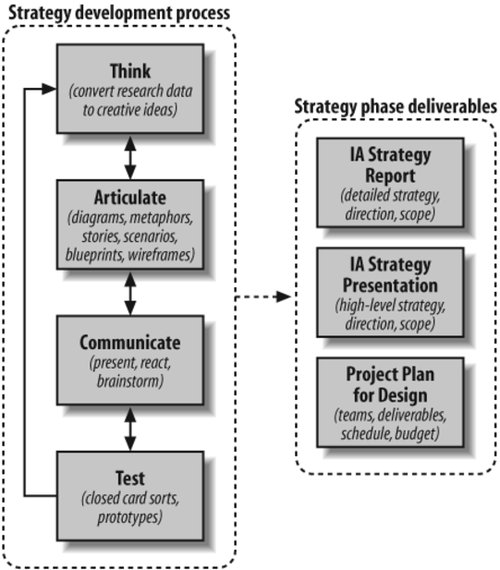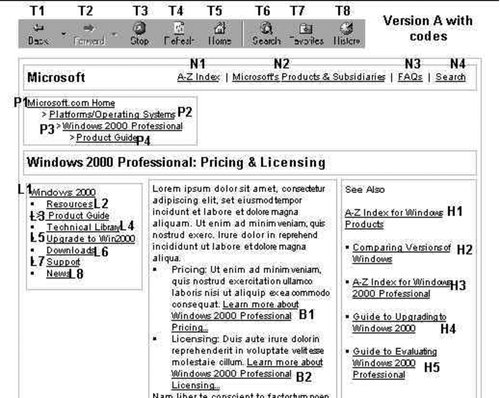Section 11.4. Developing the Strategy
11.4. Developing the StrategyThe transition from research to strategy involves a shift from a primary focus on process to a balance between process and product. Methodology is still important, but the work products and deliverables you create by applying that methodology move toward the center of attention. Moving from a mode of absorption to one of creation is often a difficult transition for the information architect. No matter how much qualitative or quantitative research you've done, the development of an information architecture strategy is inherently a creative process, with all the associated messiness, frustration, pain, and fun. Figure 11-2 presents an outline of the strategy development process and the resulting deliverables. Note the preponderance of arrows. This is a highly iterative and interactive process. Let's take a look at the four steps along the path: think, articulate, communicate, and test (TACT). Figure 11-2. Developing the information architecture strategy with TACT 11.4.1. ThinkThe human mind is the ultimate black box. Nobody really understands the process by which input (e.g., research data) is converted into output (e.g., creative ideas). Our advice is to use whatever works best for you. Some people think best by themselves, while taking a long walk or doodling on a pad of paper. Others think best in a group setting. The key is to recognize that you need to create some time and space to digest all that you've learned during research and become ready to be productive. 11.4.2. ArticulateAs your ideas begin to form, it's important to begin articulating them. It's best to start informally, scribbling diagrams and notes on paper or whiteboard. Stay away from visual design software at this point; otherwise, you'll waste energy on layout and formatting when you should be focused on developing your ideas. Once again, some people work best alone whereas others need a sounding board. We've seen teams of two or three information architects work well together to flesh out ideas, collaborating around design of high-level visuals on a whiteboard. We've also seen environments where teams of eight or more people from a variety of backgrounds lock themselves in a room for day-long "collaborative design workshops." In our experience, these have been highly inefficient, unproductive exercises that lead to groupthink and exhaustion. Large group meetings may be good for brainstorming and sharing reactions, but not for designing complex systems. 11.4.3. CommunicateEventually, you'll make the shift from creating ideas to communicating them. You'll need to identify the most effective ways to communicate these particular ideas to your target audience. Your architect's toolbox may include metaphors, stories, use case scenarios, conceptual diagrams, blueprints, wireframes, reports, and presentations. Let form follow function, selecting the right communication tools for your purpose. It's often best to begin with informal communications with "safe" colleagues who will help you refine your ideas and build your confidence. You can then share your draft work products with "unsafe" colleagues, those people you can count on to ask hard questions and poke holes. This process should help you to develop your ideas and confidence so you're ready to present them to a broader group of clients or colleagues. We've learned through much experience that it's good to communicate your ideas early and often. Many of us have a natural aversion to sharing partially formed ideasour egos don't like the risk. One way to reduce your own sense of exposure is to suggest that this is a "strawman" work product, intended to provoke reactions and jump-start discussion. This explicit disclaimer will help everyone feel comfortable presenting and discussing alternate viewpoints and hopefully moving toward consensus. By proactively taking this collaborative approach, you'll end up with a better information architecture strategy and more buy-in from your clients and colleagues. 11.4.4. TestWhether you're operating on a shoestring budget or have a multimillion-dollar project, there's no excuse for not testing your ideas before you lock into an information architecture strategy. Even running an informal usability test on your mom is better than nothing. Many of the methodologies covered during the research phase can be applied with minor modification to the testing of possible strategies. For example, you might present your draft work products to a few opinion leaders and stakeholders to make sure you're on the right track in terms of business context. Similarly, you might test your model against documents and applications not included in the content analysis sample to make sure your strategy will accommodate the full breadth and depth of content. However, we've found the most valuable methods for testing at this stage of the game to be variations of card sorting and task performance analysis. Closed card sorting provides a great way to observe user reactions to your high-level organization and labeling schemes. Create "category cards" for each of your high-level categories, using your recommended category labels. Then select a few items that belong in each of those categories. You may want to run this exercise a few times with items at differing levels of granularity (e.g., second-level category labels, destination documents and applications). Jumble up the cards and ask users to sort them into the appropriate categories. As users perform this exercise and think out loud, you'll get a sense of whether your categories and labels are working for them. Task performance analysis is also a useful approach. Rather than testing users' abilities to navigate the existing web site as you did during research, you can now create paper or HTML prototypes for users to navigate. Designing these prototype tests can be tricky; you need to think carefully about what you want to test and how you can construct the test to yield trustworthy results. At one end of the spectrum, you may want to isolate the high-level information architecture (e.g., categories, labels) from the interface components (e.g., graphic design, layout). You can get close to this ideal of testing the pure information architecture by presenting users with hierarchical menus and asking them to find some content or perform a task. For example, you could ask the user to find the current stock price of Cisco by navigating the following series of hierarchies:
Of course, it's impossible to completely escape interface design implications. Simply deciding how to order these categories (e.g., alphabetical, by importance, or by popularity) will impact the results. More significantly, when presenting hierarchies, you need to make an interface decision regarding the presentation of sample second-level categories. Research shows that the presentation of second-level categories can substantially increase users' abilities to understand the contents of a major category. By adding second-level categories, you can increase the "scent" of information:[*]
Advantages of these stripped-down information architecture prototype tests include:
Disadvantages include:
At the other end of the spectrum is the fully designed, web-based prototype. In most situations, this testing occurs later in the process. Developing these prototypes requires a great deal of work, some of it involving interface designers and software developers. Additionally, the tests themselves introduce so many variables that you often lose the ability to learn about user reactions to the information architecture. We often run a combination of tests, some aimed at isolating pure hierarchy and some that use simple wireframes. Wireframes are not fully designed prototypes, but they do allow us to see how users interact with the information architecture when it's embedded within the broader context of a web page, as illustrated in Figure 11-3. Figure 11-3. Sample wireframe with codes for tracking user choices during paper prototype testing Ideally, these tests will validate the information architecture strategy that you've developed. Realistically, they will help you to identity problems with your strategy and provide some insight into refining that strategy. Remember that strategy development should be an iterative process. Within the parameters of budget and schedule, the more you can move from "think" to "articulate" to "communicate" to "test" and back again, the more confident you'll be that your information architecture strategy is on the right track. |
EAN: 2147483647
Pages: 194